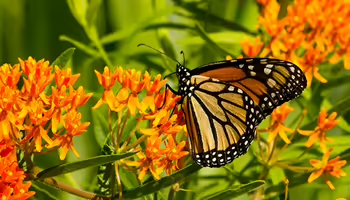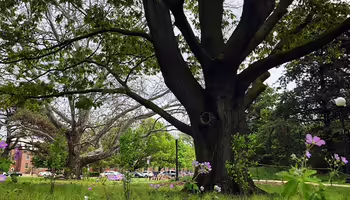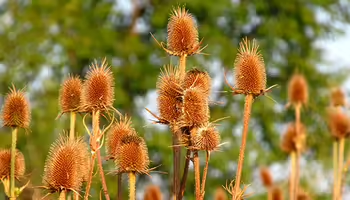Title
Wildflowers
The term “wildflowers” is frequently used but often misunderstood. Because of its broad use, it has developed many meanings and, therefore, lost some of the nuances that would help better define the plants this term encompasses.
Seed packets sold as “wildflower mixes” need to be closely examined for the species they include. They generally include showy non-native species and can even contain some species that are considered invasive. If a gardener is looking for a mix of native species, they should check with nurseries that specialize in growing native plants, instead of those from large, traditional growers.
Plants that are native to Illinois are often no longer found growing wild. In many cases, when land is not managed, the plants that grow there will be non-native, invasive plants generally considered weeds. These nuisance plants are often spread by birds and other wildlife and create large stands of their offspring, spreading onto nearby properties. With the development of land for human uses and loss of the prairies that once covered the state, coupled with the introduction of non-native and sometimes invasive plants, native flowers often have to be reintroduced. Fortunately, native flowers are well adapted to the soils and weather patterns found in Illinois and will flourish in the right habitats.
What are Native Plants?
Native plants are usually defined as plants recorded as growing wild in an area at the time that scientific collection began in that area. Other plants are considered introduced.
From a more subjective viewpoint, gardeners need to consider what native means to them. Some people are satisfied as long as the plant is considered native to North America or the United States. Others may feel that they only want to use plants native to the state in which they live. Yet others may want plants to be native to their immediate area (the ecoregion or county in which they live). Each gardener must decide what they will accept as native.
Some native plants have become “domesticated” over the years and there may be cultivated varieties, called native cultivars, or “nativars” available that differ from the species. Again, each gardener must decide if they will be a “purist,” growing only naturally occurring species, or if they will accept these cultivated varieties. The website features only naturally occurring species. Research is currently being conducted to determine if nativars are as ecologically beneficial to pollinators as the wild type, or straight species.
Seeds
Do not collect plants or seeds from wild areas as this may endanger a particular stand of plants and may be illegal. If you own the property or have permission from the property owner, collecting seed may be ok. Avoid overharvesting from one area year after year and understand the plants you are collecting. Long-lived perennial plants may not depend on new seed input, but rare or uncommon species, especially those that are short-lived, may depend on new seed inputs to maintain the population. Another option is to buy plants and seeds from reputable nurseries that are propagating plants rather than collecting them from the wild. Some native plants may be on the endangered or threatened plant list.
Native Habitat
When selecting native plants, consideration should be given to the plant’s natural habitat. Every plant species has evolved in a specific habitat and will grow best when given conditions that resemble its native habitat. Some species developed in wooded sites and so shade will be needed. Woods, however, may be dense or open, so different plants tolerate varying degrees of shade. Plants from open woods may be able to tolerate a fair amount of sun. Other species evolved in open areas like prairies and fields. These plants are usually going to need full sun.
While we can separate plants by their habitat needs, habitat conditions often overlap. Plants that are considered wetland species evolved in wet sites, such as swamps and stream banks and need a consistent amount of water (but not necessarily wet soils). Wetland plants may also be found in wooded areas that are wet and these plants would have a need for shade. Other wetland plants may have developed in wet meadows or prairies and thus would need full sun.
Selecting Native Plants
When selecting native plants, consideration should be given to the plant’s natural habitat. Each species developed in a specific habitat and will grow best when given conditions that resemble that habitat. Some species developed in wooded sites and so shade will be needed. Woods, however, may be dense or open, so different plants tolerate varying degrees of shade. Plants from open woods may be able to tolerate a fair amount of sun. Other species developed in open areas like prairies and fields. These plants are usually going to need full sun.
There is some overlap with habitats. Plants that are considered wetland plants developed in wet sites, such as swamps and stream banks and need a consistent amount of water (but not necessarily wet soils). Wetland plants may also be found in wooded areas that are wet and these plants would have a need for shade. Other wetland plants may have developed in wet meadows or prairies and thus would need full sun.
Misconceptions about Native Plants
There are some commonly held misconceptions about native plants. It is often stated that native plants have fewer disease and insect problems. This is not necessarily true. Some native plants have few problems while others are constantly plagued. We have higher expectations in a managed landscape. A native plant suffering from a disease or insect in the woods, may go unnoticed. The same plant in a traditional landscape may be more noticeable. Many people plant native plants in order to benefit native wildlife. Because of this, plants may develop holes in the leaves due to the feeding of caterpillars, leafcutter bees, and other insects. This is normal and usually not fatal to the plant. Feeding from larger animals can be deterred in the early stages with the use of fencing and caging until the plant is more established and can withstand feeding damage.
Another misconception is that native plants are always more desirable than non-native species. Poison ivy and poison sumac are natives, but they are far from desirable in a home garden. Some natives are aggressive growers, spreading rapidly. They may overwhelm a small yard or may not fit well in a traditional landscape. Other plants may have an undesirable growth form, growing large and “floppy” when planted alone. As with any plant group, careful selections need to be made. “Right plant, right place.”
Related Websites

Illinois Pollinators
Pollinators are vital to both plant life and human life on earth. Learn more about the fascinating relationship between these important insects and the plant life we all depend on.

Red Oak Rain Garden
The Red Oak Rain Garden is a living, learning environment that shows how native plants can help manage rainwater and create healthier landscapes.

Invasive Species
Invasive species are a growing threat to Illinois forests, lakes, backyards, and agricultural fields. These non-native plants can take hold quickly and be difficult to remove.